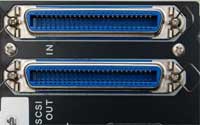Difference Between SCSI and IDE
 IDE or Integrated Drive Electronics is a standard interface for connecting hard drives into your computer’s motherboard. You can attach up to 2 hard drives on a single IDE connectors giving you up to a maximum of 4 drives attached to the system. The Small Computer Systems Interface or more commonly known as SCSI is not necessarily an interface for hard drives alone. It was intended as a universal interface for many devices; the devices that SCSI supported included hard drives, scanners, plotters, disc drives, and many more.
IDE or Integrated Drive Electronics is a standard interface for connecting hard drives into your computer’s motherboard. You can attach up to 2 hard drives on a single IDE connectors giving you up to a maximum of 4 drives attached to the system. The Small Computer Systems Interface or more commonly known as SCSI is not necessarily an interface for hard drives alone. It was intended as a universal interface for many devices; the devices that SCSI supported included hard drives, scanners, plotters, disc drives, and many more.
 SCSI has been in existence a lot longer than IDE have been. It was the most widely used interface until some of the devices it supported started to move into different standards like USB, Firewire, and IDE. It had the general advantage of being a whole lot faster due to the embedded hardware that controlled the flow of information. It had an advantage over IDE in systems that required excellent performance like mainframes and servers. SCSI had early support of RAID arrays that improved the overall speed, capacity, and reliability of hard drives by utilizing more hard drives; although more costly, it was justified by the need of mainframes to reliably store data. The maximum number of hard drives that can be attached to a single SCSI controller was also much higher compared to IDE; that was a big advantage in servers and mainframes as stated earlier.
SCSI has been in existence a lot longer than IDE have been. It was the most widely used interface until some of the devices it supported started to move into different standards like USB, Firewire, and IDE. It had the general advantage of being a whole lot faster due to the embedded hardware that controlled the flow of information. It had an advantage over IDE in systems that required excellent performance like mainframes and servers. SCSI had early support of RAID arrays that improved the overall speed, capacity, and reliability of hard drives by utilizing more hard drives; although more costly, it was justified by the need of mainframes to reliably store data. The maximum number of hard drives that can be attached to a single SCSI controller was also much higher compared to IDE; that was a big advantage in servers and mainframes as stated earlier.
But just like everything else that came to the consumer market, SCSI was slowly overshadowed by IDE due to the difference in pricing. The fact that IDE drives were cheaper than they SCSI counterparts and IDE controllers became built in to most motherboards made the IDE standard a lot cheaper compared to SCSI. The capacity of IDE was also enough for most home computers which usually just had an optical drive and 1 or 2 hard drives. IDE drives were also easier to use compared to SCSI drives. They were almost plug and play as the motherboard would just detect them. SCSI on the other hand needed to be configured before using.
SCSI is a technology that has been superseded by a myriad of other interface standards. The great number of devices that it supported was taken over by cheaper and better alternatives. IDE took over as the preferred interface between hard drives and motherboards. Despite having a lower capacity and being slower compared to SCSI, IDE tipped the scales to its favor by being drastically cheaper compared to SCSI.
- Difference Between Sony Cybershot S Series and W Series - December 22, 2012
- Difference Between Samsung Galaxy S3 and iPhone 5 - December 21, 2012
- Difference Between Samsung Galaxy S2 (Galaxy S II) and Galaxy S 4G - December 20, 2012
Search DifferenceBetween.net :
 Email This Post
: If you like this article or our site. Please spread the word. Share it with your friends/family.
Email This Post
: If you like this article or our site. Please spread the word. Share it with your friends/family.
3 Comments
Trackbacks
- Difference Between ATA and SATA | Difference Between
- Difference Between AHCI and IDE | Difference Between | AHCI vs IDE
- Difference Between AHCI and RAID | Difference Between | AHCI vs RAID

